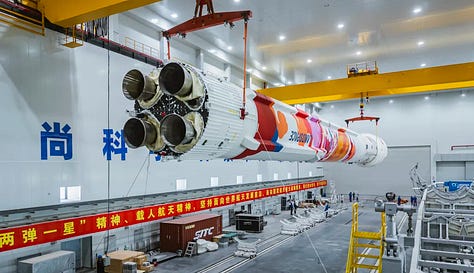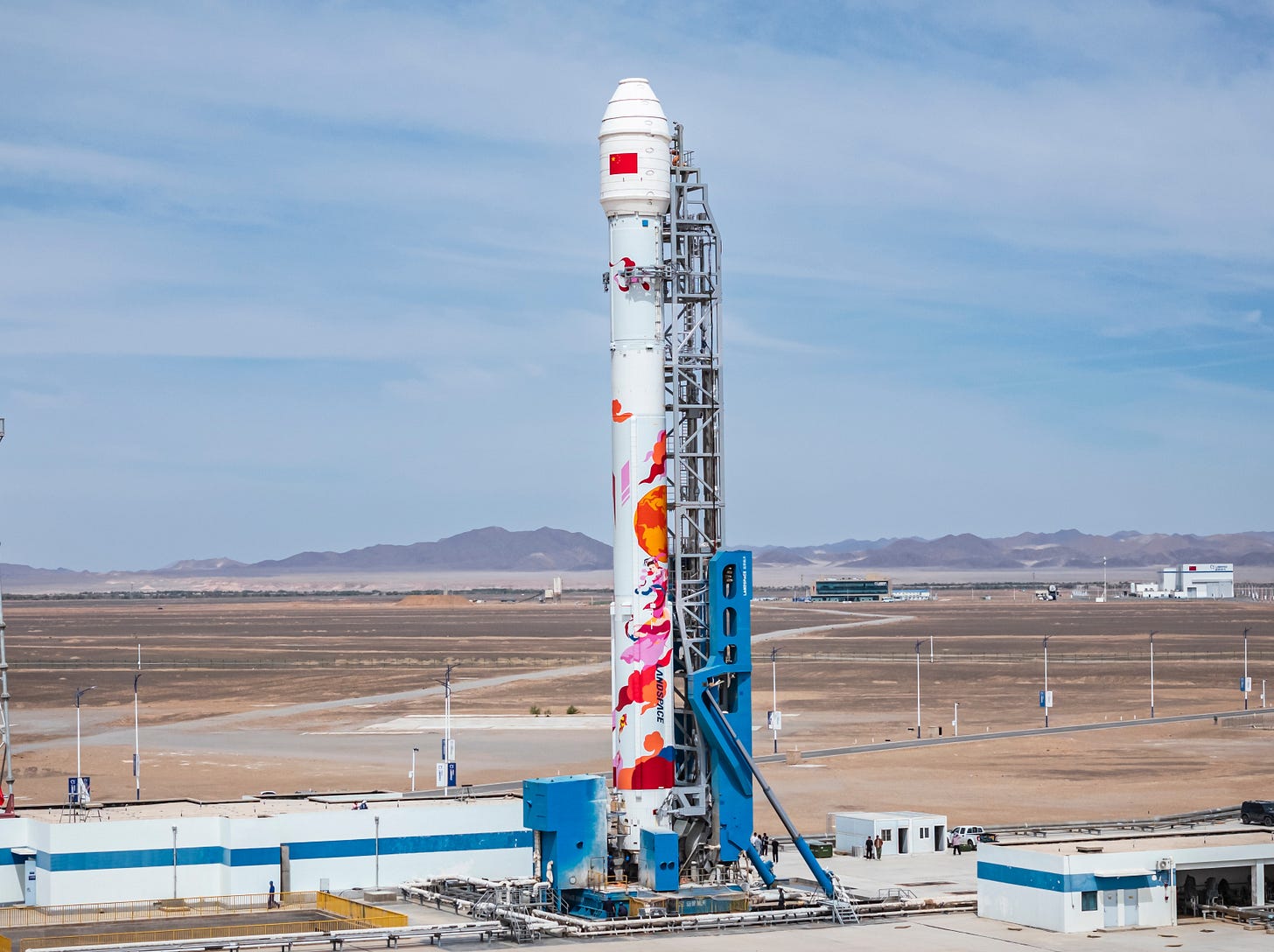LandSpace Nails Second Zhuque-2E Flight! [Zhuque-2E Y2]
An even more capable Zhuque-2E blasted off a few hours ago.
Blasting off from Launch Area 96A at the Jiuquan Satellite Launch Center, LandSpace’s Zhuque-2E flew to sun-synchronous orbit at 12:12 pm China Standard Time (04:12 am Universal Coordinated Time) on May 17th, following a scrub two days earlier. For this flight, six satellites were onboard.
Riding atop of the rocket were six Tianyi satellites, Tianyi-29 (天仪29星), Tianyi-34 (天仪34星), Tianyi-35 (天仪35星), Tianyi-42 (天仪42星), Tianyi-45 (天仪45星), and Tianyi-46 (天仪46星), developed by Spacety, full name Changsha Tianyi Space Science and Technology Research Institute (长沙天仪空间科技研究院有限公司). These satellites are expected to perform imaging of the Earth below and technical operations for a variety of customers.
Tianyi-42 is a synthetic aperture radar satellite that is claimed to be able to observe millimeter-level changes to the Earth below, with uses expected for natural resource management, infrastructure monitoring, and conservation. Tianyi-29 and Tianyi-35 are optical remote sensing satellites expected to be used for geological monitoring. Tianyi-45 and Tianyi-46 are technology demonstration satellites housing laser satellite interlinks designed to handle communications at 200 gigabits per second over a distance of 2,000 kilometers. Tianyi-34 is expected to perform space science research on charged particles around Earth and of aurora in the atmosphere.

Continuing to upgrade the Zhuque-2 series, today’s Zhuque-2E was equipped with a 4.2-meter diameter fairing, with a length of 8.7 meters, made of a composite material. LandSpace states that this fairing allows the rocket to carry a greater variety of satellites. Alongside expanding the fairing, the four first-stage engines were upgraded to the TQ-12A, providing the rocket with eleven more tons of thrust at liftoff. LandSpace’s full list of upgrades, compared to Zhuque-2E Y1, is as follows:
Fairing Upgrade to Composite Materials: For the first time, the Y2 mission is equipped with a composite payload fairing measuring 4.2 meters in diameter and 8.7 meters in total length. The nose cap uses laminated fiberglass, while the von Kármán section and cylindrical section adopt a carbon fiber sandwich structure. This significantly enhances payload compatibility and mission adaptability.
Engine Performance Improvement: The first-stage engine has been upgraded to the Tianque-12A (TQ-12A), while the second-stage engine remains the Tianque-15A (TQ-15A). The nozzle extension is made of a niobium-tungsten alloy and shaped using double-curvature sheet metal forming and laser welding techniques. These enhancements reduce weight and improve specific impulse.
Process and Structural Optimization: The first-stage liquid oxygen vent connector has been removed to simplify the launch process and improve system stability. An interstage cold separation scheme without a forward-pushing mechanism is used, achieving interstage separation during a brief microgravity phase of the second stage and reducing system complexity.
Quasi-Real-Time Wind-Corrected Trajectory Design Technology: For the first time in China, a load calculation method based on measured wind data is applied. By using quasi-real-time wind correction technology during trajectory design, flight pitch oscillation is reduced, structural design is optimized, and rocket payload capacity is improved.
If there are any problems with this translation please reach out and correct me.
This year will hopefully see the launch of five more Zhuque-2E’s, as in February, LandSpace said they were hoping to fly the vehicle six times in 2025. Hardware for the third flight is believed to be at Jiuquan while another mission was finishing assembly work in April.
In a rarity for China’s space sector, this launch was live-streamed by LandSpace. In the two hours leading up to launch, and for under an hour post-launch, the company brought on engineers and technicians to discuss the vehicle and rocketry. Additionally, the band Galaxy Express (银河快递), who LandSpace has partnered with before, was featured on stream as a copy of their music was onboard. In an artistic turn, the first-stage of the booster was painted with a mural of Chang’e, goddess of the Moon.
Today’s mission was the 2nd flight of Zhuque-2E, and the 5th flight of LandSpace’s Zhuque-2 series. This was also the 28th launch from China in 2025.
Recap via LandSpace on Weibo, Liftoff video via Vony7, China航天, and 航天五线谱, additional footage and live stream replay via International Rocket Launches on YouTube.
Check out the previous Zhuque-2E launch
Zhuque-2E soars for its first mission! [Zhuque-2E Y1]
On November 27th at 10:00 am China Standard Time, or 02:00 am Universal Coordinated Time, LandSpace’s improved Zhuque-2E launch vehicle lifted off from Launch Area 96A at the Jiuquan Satellite Launch Center. The vehicle flew as planned for eight and …
What is Zhuque-2E?
This section is for those less familiar with China's various commercial launch vehicles.
Zhuque-2E is LandSpace’s privately-developed commercial launch vehicle, and is largely based on the company’s Zhuque-2 vehicle. The vehicle consists of two stages both burning liquid methane and liquid oxygen.
The payload capacity of the launch vehicle is currently as follows:
6,000 kilograms to low Earth orbit
4,000 kilograms to a 500-kilometer sun-synchronous orbit
Four TQ-12A engines power the first stage to generate over 293 tons of thrust while burning liquid methane and liquid oxygen. The second-stage is powered by a single TQ-15A engine, also burning liquid methane and liquid oxygen, to generate 85 tons of thrust.
On the launch pad, Zhuque-2E is over 47.3 meters tall and weighs over 219,000 kilograms when fully fuelled. The first-stage and second-stage, have a diameter of 3.35 meters, while the fairing has a diameter of 4.2 meters.










![Zhuque-2E soars for its first mission! [Zhuque-2E Y1]](https://substackcdn.com/image/fetch/$s_!NQF1!,w_1300,h_650,c_fill,f_auto,q_auto:good,fl_progressive:steep,g_auto/https%3A%2F%2Fsubstack-post-media.s3.amazonaws.com%2Fpublic%2Fimages%2Faa2beeaf-534e-49d9-b0d6-2f975a49d4cc_1280x733.jpeg)
